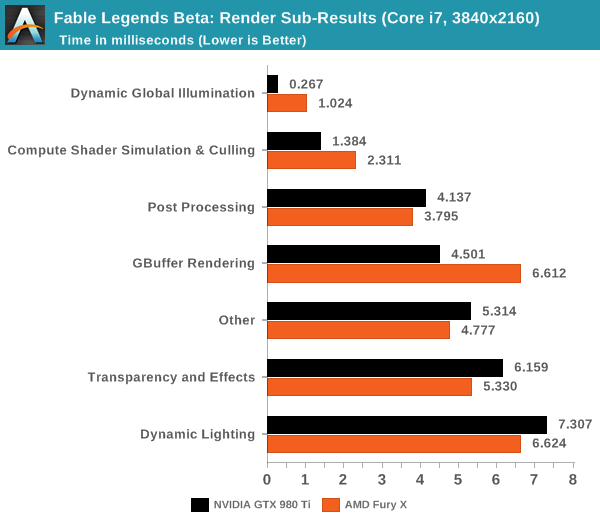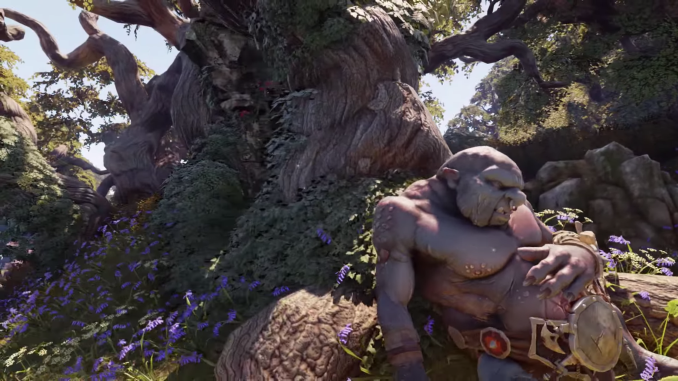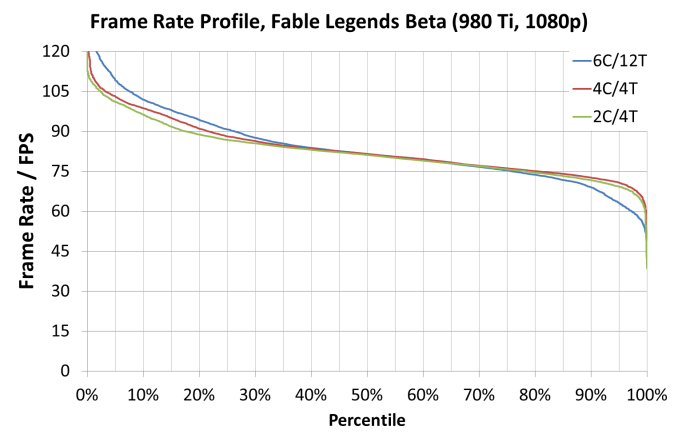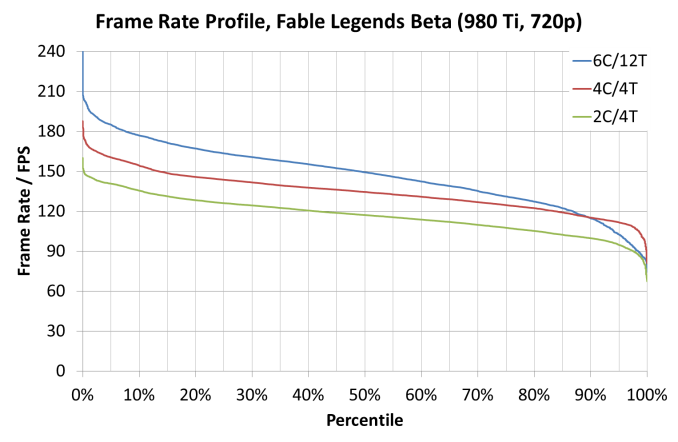Fable Legends Early Preview: DirectX 12 Benchmark Analysis
by Ryan Smith, Ian Cutress & Daniel Williams on September 24, 2015 9:00 AM ESTFinal Words
Non-final benchmarks are a tough element to define. On one hand, they do not show the full range of both performance and graphical enhancements and could be subject to critical rendering paths that cause performance issues. On the other side, they are near-final representations and aspirations of the game developers, with the game engine almost at the point of being comfortable. To say that a preview benchmark is somewhere from 50% to 90% representative of the final product is not much of a bold statement to make in these circumstances, but between those two numbers can be a world of difference.
Fable Legends, developed by Lionhead Studios and published by Microsoft, uses EPIC’s Unreal 4 engine. All the elements of that previous sentence have gravitas in the gaming industry: Fable is a well-known franchise, Lionhead is a successful game developer, Microsoft is Microsoft, and EPIC’s Unreal engines have powered triple-A gaming titles for the best part of two decades. With the right ingredients, therein lies the potential for that melt-in-the-mouth cake as long as the oven is set just right.
Convoluted cake metaphors aside, this article set out to test the new Fable Legends benchmark in DirectX 12. As it stands, the software build we received indicated that the benchmark and game is still in 'early access preview' mode, so improvements may happen down the line. Users are interested in how DX12 games will both perform and scale on different hardware and different settings, and we aimed to fill in some of those blanks today. We used several AMD and NVIDIA GPUs, mainly focusing on NVIDIA’s GTX 980 Ti and AMD’s Fury X, with Core i7-X (six cores with HyperThreading), Core i5 (quad core, no HT) and Core i3 (two cores, HT) system configurations. These two GPUs were also tested at 3840x2160 (4K) with Ultra settings, 1920x1080 with Ultra settings and 1280x720 with low settings.
On pure average frame rate numbers, we saw NVIDIA’s GTX 980 Ti by just under 10% in all configurations except for the 1280x720 settings which gave the Fury X a substantial (10%+ on i5 and i3) lead. Looking at CPU scaling, this showed that scaling only ever really occurred at the 1280x720 settings anyway, with both AMD and NVIDIA showing a 20-25% gain moving from a Core i3 to a Core i7. Some of the older cards showed a smaller 7% improvement over the same test.
Looking through the frame rate profile data, specifically looking for minimum benchmark percentile numbers, we saw an interesting correlation with using a Core i7 (six core, HT) platform and the frame rates on complex frames being beaten by the Core i5 and even the Core i3 setups, despite the fact that during the easier frames to compute the Core i7 performed better. In our graphs, it gave a tilted axis akin to a seesaw:
When comparing the separate compute profile time data provided by the benchmark, it showed that the Core i7 was taking longer for a few of the lighting techniques, perhaps relating to cache or scheduling issues either at the CPU end or the GPU end which was alleviated with fewer cores in the mix. This may come down to a memory controller not being bombarded with higher priority requests causing a shuffle in the data request queue.

When we do a direct comparison for AMD’s Fury X and NVIDIA’s GTX 980 Ti in the render sub-category results for 4K using a Core i7, both AMD and NVIDIA have their strong points in this benchmark. NVIDIA favors illumination, compute shader work and GBuffer rendering where AMD favors post processing, transparency and dynamic lighting.
DirectX 12 is coming in with new effects to make games look better with new features to allow developers to extract performance out of our hardware. Fable Legends uses EPIC’s Unreal Engine 4 with added effects and represents a multi-year effort to develop the engine around DX12's feature set and ultimately improve performance over DX11. With this benchmark we have begun to peek a little in to what actual graphics performance in games might be like, and if DX12 benefits users on low powered CPUs or high-end GPUs more. That being said, there is a good chance that the performance we’ve seen today will change by release due to driver updates and/or optimizing the game code. Nevertheless, at this point it does appear that a reasonably strong card such as the 290X or GTX 970 are needed to get a smooth 1080p experience (at Ultra settings) with this demo.














141 Comments
View All Comments
lprates - Sunday, October 18, 2015 - link
I totally Agreeanubis44 - Friday, October 30, 2015 - link
It's not nonsense. AMD Radeon cards have a hardware based scheduler. These tests don't make any use of asynchronous shaders, but it IS a DX12 feature, and one which will hit the Maxwells hard, since they don't have a hardware based scheduler. nVidia left it out to get the power consumption down. Too bad it'll be needed in many upcoming DX12 titles.Bleakwise - Tuesday, December 29, 2015 - link
You think?They didn't even benchmark the 300 series cards and look at this, at 1080p a 290x is about 11% faster a 970, a 285 is 20% faster than 960.
I mean holy shit.
Also, why didn't Anandtech use the last gen AMD cards instead of the 300 series cards (no, they aren't just rebrands)? Why didn't they do 1440p benchmarks? What the hell?
Bleakwise - Tuesday, December 29, 2015 - link
Also, "the driver got here late" my ass.What a bullshit excuse. It takes a couple hours to benchmark a card. The review couldn't wait one more day? Really? A review that's obsolete before it's even posted is better than posting a relevant review a day later?
Uxi - Thursday, September 24, 2015 - link
Picture/Graph nr. 2 on the CPU scaling page seems to be the wrong. Should be 980 Ti not Fury X.Brett Howse - Thursday, September 24, 2015 - link
Fixed tyvm!Drumsticks - Thursday, September 24, 2015 - link
Any chance of having some AMD cpus tacked onto this? DX 12 is supposed to help them out after all, so it would be interesting to see if they've made any gains here.Ian Cutress - Thursday, September 24, 2015 - link
It's something we've thought of. A main issue is that the reviewer with all the GPUs, Ryan, is on the West Coast and the one with all the CPUs, me, is in Europe. So if Ryan does a piece it'll have lots of GPUs (and take time out of other things as he is Editor in Chief) and light on CPU. If I do it, it'll be limited to the GPU stack (R9 290X, R9 285, GTX 980, GTX 770, some of these non-reference) I have. We did this with Star Swarm and got a select group of angry emails claiming we were biased some way or another for not doing a full matrix intersection and claimed we were being paid off.That aside, when we get closer to launch of this game and others with DX12, I'll update the tests on our CPU test bed for 2016, and maybe get a new GPU or two with whatever is available at the time.
britjh22 - Thursday, September 24, 2015 - link
Sounds like we need to get Ryan an FX-8320 and 990FX board, can you partially disable the FX processors in the same way to replicate the 6 and 4 series like you can with the i7?R0H1T - Thursday, September 24, 2015 - link
A better idea would be to ship Ian to the states, also since import duties are lower than that in Europe (:j/k